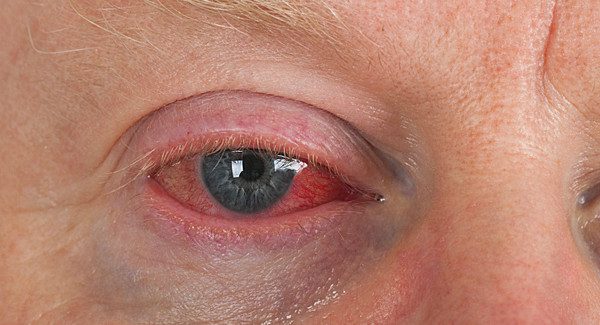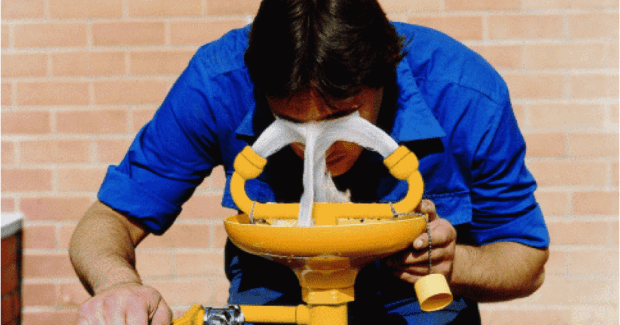How to Identify Safe and Effective Emergency Eyewash — and the Hidden Dangers to Avoid
While the FDA states that ophthalmic drug products should be sterile, ANSI does not require that emergency eyewash solution or its delivery mechanism be sterile. Yet the dangers of administering non-sterile eyewash can have profoundly negative impacts on injured individuals, as well as their employers.
Posted: January 27, 2014
The human eye is a complex and intricate organ that provides us with the invaluable sense of sight. Commonly referred to as our windows to the world, eyes allow us to take in the majority of information we obtain about the environment around us. In fact, experts agree that the eyes contribute nearly 85 percent of an individual’s total knowledge. Because we rely on our eyes for nearly every activity we perform, most individuals value the sense of sight above all others.
The eyes are considered the most complex organs in the human body, second only to the brain. Each eye is made up of more than two million working parts and is capable of detecting more than ten million colors. The human eye can process 36,000 bits of information every hour, and its lens is faster than any existing camera lens. No human inventions, including computer-assisted cameras, rival the human eye in complexity and function.
Measuring about one inch diameter in adulthood, the eye is made up of three tissue layers. The outer layer is the cornea, a clear covering that helps focus light entering the eye. The middle layer is the iris, whose adjustable circular opening – the pupil – contracts and expands to control the amount of light that travels deeper into the eye. Located at the back of the eye is the retina. Measuring approximately a quarter millimeter thick, the retina is made up of ten distinct layers and contains more than 125 million receptors. It focuses images and sends electric signals to the brain via the optic nerve at a rate of 300 mph. The brain translates these electric signals into the images we see. Because of its direct connection to the brain, the retina is considered part of the central nervous system.
PROTECTING THE EYES IS CRUCIAL
Given the eyes’ complexity, size and location, it is easy to understand that they are also extremely vulnerable to injury. Eyes are susceptible to hazards encountered every day outside of work such as flying or falling objects in the yard, sand and dust particles, chemicals and vapors from household cleaning products and even ultraviolet light. Likewise, most workplace environments contain potential eye hazards — and in many workplaces eye hazards are abundant.
http://youtu.be/i24Atz0sIaQ
A training video showing how to install and use the Fendall Pure Flow 1000 Emergency Eyewash Station by Honeywell Safety Products.
According to the Occupational Safety and Health Administration (OSHA), more than 2,000 people injure their eyes at work each day in the U.S. Roughly one in ten of those individuals requires one or more missed workdays to recover, and 10 percent to 20 percent of all occupational eye injuries result in temporary or permanent vision loss.
For this reason, national standards are in place to protect individuals’ eyes at work. In the U.S., OSHA requires employers to provide employees with suitable eye and face protection “whenever necessary to protect against chemical, environmental, radiological or mechanical irritants and hazards.” While OSHA publishes the general framework for eye protection and emergency eyewash workplace practices and hazard assessments, it refers to the American National Standards Institute (ANSI) for performance requirements relating to personal protective equipment and eye safety. The Canada Occupational Health and Safety (OHS) regulations are similar in scope for that country to those set by OSHA in the U.S., while the Canadian Standards Association maintains detailed standards in a similar fashion to ANSI.
ANSI Z87.1 compliant eye protection in the form of safety spectacles or goggles is suitable to protect from most common hazards found in the workplace. In identified high-hazard areas, however, face shields or welding helmets may be required to provide additional, secondary protection. Many employers supplement ANSI guidelines by implementing eye safety protocols above and beyond national standards to meet their site’s specific needs and safety goals. Together, these national and corporate-level efforts have successfully reduced the number of occupational eye injuries in recent decades.
The cost of lost vision to an individual is immeasurable, spanning medical expenses, diminished quality of life and the reduced ability to earn a living. Furthermore, workplace eye injuries cost employers more than $467 million in direct costs per year, according to the U.S. Bureau of Labor Statistics (BLS). Once indirect costs such as legal fees, judgments and training new workers are factored in, that estimated total exceeds $934 million per year, according to Prevent Blindness America (Chicago, IL).
PROPER INJURY RESPONSE IS IMPERATIVE
When an eye injury occurs, proper and immediate treatment is the best defense for both a positive outcome and minimal financial impact. The ANSI Z358.1-2009 standard for “Emergency Eyewash and Shower Equipment” establishes a universal minimum performance and use requirement for all eyewash and drench shower equipment used for the treatment of the eyes, face, and body of a person who has been exposed to hazardous materials and chemicals. Because there is no Canadian standard for the design or placement of eyewash stations, the ANSI standard is generally used as a guide in that country as well.
ANSI requires that the first step following chemical contact of any kind with the eye(s) – including caustics, acids, solvents and other hazardous materials – is immediate flushing of the eyes with water. According to the standard, such water may be any potable (drinking) water, preserved water, preserved buffered saline solution or other medically acceptable solution.
The first 10 to 15 seconds after exposure to a hazardous substance, especially a corrosive substance, are critical. Delaying treatment, even for a few seconds, may cause serious injury. For this reason, ANSI calls for eyewash stations to be located within a 10-second walk from the hazard. To ensure easy access to a station within ten seconds, it must be located on the same level as the hazard with no steps, stairs or obstructions. In the case of strong caustics and strong acids, eyewash must be located immediately adjacent to the hazard. The area surrounding the station should be well lit and marked with a sign that is highly visible to everyone served by it.
Once an injured worker reaches the station, ANSI calls for the eyes to be flushed continuously for a full 15 minutes with fluid flowing at a rate of 0.4 gpm for portable and plumbed eyewash stations. This fluid must be delivered at a tepid temperature, defined as ranging between 60 deg F and 100 deg F in order to safely treat eyes without causing further injury or discomfort. Fluid that is too cold may prevent the worker from flushing for the full 15 minutes, and fluid exceeding 100 deg can harm the eyes and even exacerbate chemical reaction with the eyes and skin.
The first 10 to 15 seconds after exposure to a hazardous substance, especially a corrosive substance, are critical. Delaying treatment, even for a few seconds, may cause serious injury. For this reason, ANSI calls for eyewash stations to be located within a 10-second walk from the hazard.
PRIMARY EYEWASH DELIVERY OPTIONS
ANSI calls for eyewash to be present at the site of any hazardous material that can cause adverse effects on an individual’s health and safety. Because such hazards exist in nearly every workplace, primary eyewash stations are also required in nearly every workplace. The options available for eyewash delivery systems and the fluids they deliver are vast — but not all flushing fluids are equal in content, manufacture, safety or even intended use. Making informed selections can significantly affect the outcome of an injury to an individual and its impact on an employer.
Plumbed units
Primary eyewash can be delivered by either a plumbed or a portable unit. Plumbed eyewash stations have been a long-standing solution because they deliver tap water in plentiful amounts. However, they are expensive to install, impractical to move and require weekly maintenance. Furthermore, tap water has been proven detrimental in treating injured eyes. Because its temperature is not easily regulated, plumbed water is often too hot or too cold to carry out ANSI’s required 15-minute flush. Since it does not match the eye’s natural pH, flushing with it can cause further irritation. Similarly, harmful microorganisms and other contaminants commonly found in tap water can cause serious long-term effects.





